This site is supported by our readers. We may earn a commission, at no cost to you, if you purchase through links.
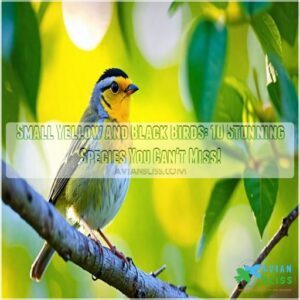
Among these are the American Goldfinch, known for its vibrant colors and bouncy flight, or perhaps the cheeky Lesser Goldfinch with its cheery song.
These birds, often found in meadows and gardens, enjoy seeds and insects, making them both colorful and useful garden guests.
Their bright hues and melodious calls add a splash of sunshine to your day.
Curious about their unique behaviors or distinctive songs? You’re in the right place to discover what makes these feathered friends truly fascinating!
Table Of Contents
- Key Takeaways
- Small Yellow and Black Birds Overview
- Common Small Yellow and Black Birds
- Small Yellow and Black Birds Identification
- Small Yellow and Black Birds Diet and Foraging
- Small Yellow and Black Birds Breeding and Nesting
- Small Yellow and Black Birds Conservation Status
- Unique Small Yellow and Black Birds
- Frequently Asked Questions (FAQs)
- Are black and Yellow Birds common?
- What birds are yellow?
- What are black & yellow bird species?
- What bird is yellow with black wings?
- What does a yellow bird look like in summer?
- What is the difference between yellow and black birds?
- What is a yellow and black small bird called?
- What is the yellow bird that looks like a goldfinch?
- What are the little yellow birds with black head?
- What is a blackbird with yellow spot?
- What attracts small yellow and black birds to yards?
- Do small yellow and black birds migrate?
- How do weather changes affect their behavior?
- Are small yellow and black birds commonly found in cities?
- How can I photograph small yellow and black birds effectively?
- Conclusion
Key Takeaways
- You’ll often spot small yellow and black birds like the American Goldfinch and Lesser Goldfinch brightening up gardens and meadows with their vivid plumage.
- Identifying these birds gets easier when you focus on their unique color patterns, listen for their songs, and observe their nesting habits.
- Keep in mind that many of these birds, such as the American Goldfinch, migrate in search of food, adapting to various habitats from fields to urban areas.
- You can attract these charming birds to your yard by providing seed-bearing plants, water sources, and shrubs for food and shelter.
Small Yellow and Black Birds Overview
You’ll find small yellow and black birds in various habitats, from woodlands to open fields, each with unique physical traits and behaviors.
These vibrant species, ranging from the American Goldfinch to the Western Tanager, can be found in various habitats, including those in California’s diverse ecosystems, display distinctive yellow and black plumage patterns, making them a joy for birdwatchers to spot and identify.
Physical Characteristics
You’ll find small yellow and black birds come in a variety of shapes and sizes.
Small yellow and black birds may resemble the yellow-headed blackbird, which boasts a striking golden helmet and distinctive white wing stripe pattern. These stunning species often sport vibrant yellow plumage paired with bold black markings.
Their coloration ranges from pale to bright yellow, with black accents on wings, tails, or heads.
Some, like warblers, have sleek bodies and pointed beaks, while others, like goldfinches, boast rounder shapes.
Their unique patterns and characteristics make bird identification an exciting challenge for nature enthusiasts.
Habitat and Distribution
These vibrant little birds aren’t just eye-catching; they’re found across diverse habitats.
From American Goldfinches in weedy fields to Hooded Warblers in dense forests, each species has its preferred home.
Seasonal variations and migration patterns affect their geographic ranges.
Some, like Prairie Warblers, prefer low elevations, while others thrive at higher altitudes.
Sadly, habitat loss impacts many North American birds, making backyard birdwatching essential for their conservation.
Behavioral Traits
Small yellow and black birds exhibit fascinating behavioral traits that set them apart.
As you observe these feathered friends, you’ll notice their unique social interactions and flocking patterns.
Their courtship displays are a sight to behold, while their migratory habits and foraging strategies showcase their adaptability.
Let’s explore some key behaviors:
- Intricate social hierarchies within flocks
- Elaborate courtship rituals involving song and dance
- Seasonal migration patterns covering vast distances
- Cooperative foraging techniques for efficient feeding
- Complex vocalizations for communication and territory defense
Common Small Yellow and Black Birds
You’ll often spot common small yellow and black birds like the American Goldfinch, Lesser Goldfinch, Hooded Warbler, and Prairie Warbler in various habitats across North America.
These species display distinct yellow and black plumage patterns, making them easily recognizable and popular among birdwatchers.
American Goldfinch
The American Goldfinch is a bright spot in any backyard.
This vibrant bird undergoes fascinating changes throughout the year.
Let’s explore its life cycle:
| Season | Appearance | Behavior |
|---|---|---|
| Spring | Bright yellow | Courtship begins |
| Summer | Golden plumage | Nesting and feeding young |
| Fall | Dull olive-brown | Molting and migration prep |
| Winter | Muted colors | Flocking and foraging |
| Year-round | Variable | Social at bird feeders |
Watch for these charming birds at your feeder, especially if you offer their favorite snack: nyjer seeds.
Lesser Goldfinch
While American Goldfinches sport vibrant yellow plumage, their close cousins, Lesser Goldfinches, offer a unique twist. You’ll spot these petite birds flitting about, their yellow-and-black feathers catching the sunlight. They’re nature’s little acrobats, often seen hanging upside down to snag seeds. Attracting these birds to your garden can be as simple as incorporating the right seeds and flowers as Goldfinch attractants.
- Lesser Goldfinch Diet: Mainly seeds, especially from sunflowers and thistles
- Lesser Goldfinch Migration: Partial migrants, some populations stay year-round
- Lesser Goldfinch Nesting Habits: Compact cup nests in trees or shrubs
- Lesser Goldfinch Conservation: Currently stable, but habitat loss is a concern
- Lesser Goldfinch Sounds: High-pitched twitters and warbling songs
Hooded Warbler
Moving from the Lesser Goldfinch, you’ll find the Hooded Warbler equally fascinating.
This striking bird sports a black hood and throat, contrasting beautifully with its yellow face and underparts.
During Hooded Warbler migration, they travel from eastern North America to the Caribbean.
Their diet consists mainly of insects, which they catch with impressive aerial maneuvers.
Listen for their distinctive "weeta weeta weeteo" song in deciduous forests, where they build cup-shaped nests for breeding.
Prairie Warbler
Prairie Warblers catch your eye with their bright yellow plumage and distinctive black stripes.
You’ll often hear their ascending buzz-like song in shrubby fields and young forests.
These small songbirds feast on insects and spiders, gleaning them from leaves and twigs.
During migration, they travel to warmer climates, swapping their breeding grounds for Caribbean islands.
Keep an ear out for their unique song to spot these charming birds.
Small Yellow and Black Birds Identification
You’ll find identifying small yellow and black birds easier by focusing on their distinct features and behaviors.
Look for unique color patterns, listen for their songs, and observe their nesting habits to accurately identify these vibrant species.
Visual Identification
Identifying small yellow and black birds can be a rewarding challenge.
Consider these field marks:
- Plumage Variations: The Common Yellowthroat sports a black mask.
- Size Comparisons: Lesser Goldfinch is smaller than Eastern Meadowlark.
- Juvenile Plumage: Ducklings have fuzzier appearances.
- Molt Patterns: Scott’s Oriole changes subtly.
Each bird’s distinct traits help you spot them effortlessly!
Song and Call Identification
When you’re out birdwatching, tuning into bird vocalizations is key.
The Evening Grosbeak‘s robust notes contrast sharply with the soft warbling of the Magnolia and Pine Warblers.
You can even use a bird call identifier to help you identify these birds by their calls.
Field guides featuring sound recordings can help tackle identification challenges.
Engage in mimicry analysis to distinguish the Townsend’s Warbler and Hooded Oriole, enhancing your birding skills with each melodious chip and chirp.
Nesting and Breeding Identification
Noticing unique songs helps pinpoint species, but you’ll need to recognize nesting and breeding clues too.
Consider these aspects: Birders often use avian nesting guides to learn more about different species’ nesting habits.
- Nest Site Preferences: Different species pick specific spots.
- Egg Color Variation: Eggs range from blue to speckled.
- Breeding Season Timing: Some delay breeding for ideal weather.
- Parental Care: Birds invest heavily in nestling development.
These insights simplify bird ID challenges.
Small Yellow and Black Birds Diet and Foraging
You’ll discover that these birds’ diets vary widely, depending on the species. Some are dedicated seed-eaters, others prefer insects, and a few even enjoy a bit of nectar.
Seed-Eating Birds
Ever wondered how seed-eating birds thrive?
Well, it comes down to choosing the right seed types for species like the Yellowbellied Siskin or Hooded Siskin.
These birds have feeder preferences, especially during migration patterns.
Watching them crack seeds with finesse shows their winter survival skills.
Conservation efforts help these charming creatures, including the Village Weaver, thrive.
Insectivorous Birds
Seed lovers share space with insect-eating avians—effortless navigators of ecology.
These birds feast on insects, aiding ecosystems by controlling pest populations, and preparing for bird migration.
Watch for:
- Western Tanager’s vibrant catches
- Common Hill Myna’s clever foraging
- Audubon’s Oriole’s adept hunting
- Altamira Oriole’s stealthy pursuits
- Yellow-throated Toucan’s diverse diet
They’re champions against food scarcity and nest parasites.
Nectar-Feeding Birds
After exploring insectivorous habits, let’s chat about nectar-feeding birds.
They’ve mastered sipping nectar with precision, their tongues like tiny straws.
To attract these birds, consider planting nectar-rich flowers like fuchsias and petunias, which are often favored by small yellow birds.
Nectar sources attract New Holland Honeyeaters, Goldenwinged Sunbirds, and Hispaniolan Orioles.
Check out their flower preferences and migration patterns below:
| Bird | Flower Preferences | Migration Patterns |
|---|---|---|
| New Holland Honeyeater | Banksia, Grevillea | Localized, limited travel |
| Goldenwinged Sunbird | Hibiscus | Seasonal, long distances |
| Hispaniolan Oriole | Various exotic | Resident, stays local |
Small Yellow and Black Birds Breeding and Nesting
You’ll find that small yellow and black birds engage in fascinating behaviors during breeding season, establishing territories and attracting mates with vibrant displays.
Nest construction often happens mid-summer, carefully timed when food is plentiful, ensuring successful rearing of their young.
Territorial Behavior
You might wonder how small yellow and black birds show territorial behavior.
They use various strategies to defend their nests and resources.
Here’s what to look for:
- Bird aggression: Watch for chasing rivals.
- Mating rituals: Unique displays to secure territory.
- Nest defense: Vocalizations and physical barriers.
- Food competition: Protecting feeding grounds.
Stay curious and listen closely to bird sounds!
Mating and Pair Bonding
In the bird world, courtship rituals often resemble nature’s very own dance-off.
Yellowrumped Cacique and Goldenheaded Manakin flaunt elaborate mating displays to strengthen bond strength.
Regent Bowerbird’s colorful antics charm potential partners.
These birds, from Goldencollared Manakin to Spekes Weaver, impress with unique gestures, showcasing compatibility.
Such behaviors guarantee successful mating and effective parental care, leaving no doubt about their dedication.
Nest Construction and Egg Laying
With amazing ingenuity, you’ll find these birds use diverse nest materials, creating cozy homes.
Egg coloration varies greatly, from pale blue to speckled brown.
Incubation periods and brood sizes differ between species.
Nestling care involves feeding and protecting the young.
Species like the Baya Weaver, Streaked Weaver, and various Masked Weavers showcase unique nesting behaviors.
Understanding these intricacies adds to the wonder of these small, vibrant birds.
Small Yellow and Black Birds Conservation Status
Explore the conservation status of small yellow and black birds, focusing on threats like habitat loss, fragmentation, and climate change impacts.
Understanding these challenges helps you appreciate the importance of conservation efforts for these vibrant species.
Threats to Populations
Think about how these charming birds, like the Western Meadowlark and Yellowbrowed Bulbul, face tough challenges.
They cuddle up in their nests, but threats lurk—pesticide use, climate change, invasive species, and disease outbreaks.
Species like the Lesser Masked Weaver and Himalayan Blacklored Tit struggle to thrive.
Understanding these threats helps us protect these colorful creatures in their natural habitats.
Habitat Loss and Fragmentation
You’re witnessing challenges that small yellow and black birds face due to habitat loss and fragmentation.
Urban sprawl pushes these beauties to the brink.
For instance, the Yellow-headed Blackbird, which makes its home in freshwater wetlands and cattail marshes, faces threats from habitat loss.
Here’s how you can help:
- Support habitat restoration efforts.
- Promote wildlife corridors.
- Participate in local conservation events.
- Educate your community about protecting bird habitats.
These actions can preserve our winged friends’ habitats!
Climate Change Impacts
Witnessing the climate change impacts on small yellow and black birds might make you scratch your head.
Shifting migration patterns and habitat shifts mean a juggling act for these birds.
You’ll notice food availability affecting breeding seasons, raising concerns for Flamethroated Bulbul and others.
As these wildlife wonders face population declines, understanding their nature becomes essential.
Unique Small Yellow and Black Birds
You’ll be fascinated by the unique features of small yellow and black birds, like the Western Tanager and Evening Grosbeak.
These birds delight with their striking plumage but also intrigue with their distinctive behaviors and habitats.
Western Tanager
While pondering the conservation of yellow and black birds, you may know that the Western Tanager is a winter visitor that journeys to its breeding grounds during spring migration, often found in coniferous habitats. You’re swiftly drawn to the Western Tanager.
This bird’s vibrant plumage stands out amid its montane forest habitat, and their migration patterns amaze birding enthusiasts.
To attract these birds to your yard, consider installing a Western Tanager Birdhouse.
Don’t overlook their diverse diet, including insects and fruit.
These birds’ nesting practices reflect adaptability and resilience, key traits in their ongoing conservation efforts.
Evening Grosbeak
Have you spotted an Evening Grosbeak?
These striking birds boast a vibrant yellow and black plumage.
Their diet consists mainly of seeds and buds.
Evening Grosbeak nesting habits involve building sturdy cups in trees.
Their songs are quite melodic, a delightful treat for bird enthusiasts.
Sadly, Evening Grosbeak Conservation is essential due to habitat loss.
Learn more about their migration patterns and help protect these beautiful creatures!
Common Yellowthroat
After exploring the vibrant Evening Grosbeak, let’s check out the Common Yellowthroat, a charming warbler with its striking black mask.
You might catch its vibrant Common Yellowthroat Song echoing through marshes and grasslands.
It prefers dense, wet habitats, expertly weaving nests close to the ground.
This bird’s diet includes insects, adapting its feeding to the season, and has intriguing migration patterns.
Frequently Asked Questions (FAQs)
Are black and Yellow Birds common?
Black and yellow birds, like American Goldfinches and Yellow-headed Blackbirds, are fairly common across various habitats in North America.
You can spot these vibrant birds in fields, gardens, and wetlands, adding color to your birdwatching adventures.
What birds are yellow?
Like sunbeams in flight, many birds flaunt yellow hues.
The American Goldfinch, Common Yellowthroat, and Western Tanager are a few examples.
These species captivate with their vibrant plumage, often becoming the stars of birdwatching adventures.
What are black & yellow bird species?
You might spot birds with vibrant plumage, like the Yellow Warbler, known for its delightful songs and vibrant plumage. You might spot black and yellow bird species like the American Goldfinch, Yellow-headed Blackbird, and the Western Tanager.
They bring bursts of color to wetlands, fields, and forests with their striking plumage and lively songs.
What bird is yellow with black wings?
That’s a tricky one!
Several birds fit that description.
Consider the American Goldfinch, known for its bright yellow body and striking black wings.
Its size and habitat might help you narrow it down.
Further research will confirm your sighting.
What does a yellow bird look like in summer?
In summer, a yellow bird, like the American Goldfinch, flaunts bright yellow feathers paired with striking black wings and tail.
Its vibrant plumage attracts attention, creating a cheerful and lively presence in natural settings.
What is the difference between yellow and black birds?
Birds of a feather flock together, but Yellow-headed Blackbirds, which thrive in freshwater marshes, boast a unique distinction: the American Goldfinch features vibrant yellow plumage and black accents, whereas the Yellow-headed Blackbird showcases a striking yellow head with a deep black body.
What is a yellow and black small bird called?
You might be thinking of the American Goldfinch or Lesser Goldfinch.
Both display vibrant yellow and black colors, with the American Goldfinch being slightly larger.
Look for their cheerful flight patterns and listen for their distinct songs.
What is the yellow bird that looks like a goldfinch?
Spotting a yellow bird resembling a goldfinch, with bright yellow plumage and distinctive song, similar to the common yellow birds in ohio. Spotting a yellow bird resembling a goldfinch?
It might be the American Goldfinch during late summer molting or a Lesser Goldfinch.
Both species showcase bright plumage and small stature, making them easily confused.
Happy birdwatching!
What are the little yellow birds with black head?
Imagine you spot a small yellow bird with a black head.
You’re likely looking at a Common Yellowthroat, a charming warbler with striking colors and a lively personality, often seen darting in low vegetation.
What is a blackbird with yellow spot?
A blackbird with a yellow spot might be the Yellow-headed Blackbird, known for its striking yellow head and black body.
Look for this bird in freshwater wetlands with tall vegetation, like cattails.
What attracts small yellow and black birds to yards?
Seed-bearing plants, like sunflowers and thistles, draw them in. Water sources and shrubs offer shelter. You’ll attract more birds by providing these essentials. They’re drawn to safety and food.
Do small yellow and black birds migrate?
Many small yellow and black birds, like the American Goldfinch, migrate to seek warmer climates and abundant food.
In winter, they move southward, enjoying areas where seeds and insects remain plentiful, helping them survive the colder months.
How do weather changes affect their behavior?
Weather nudges yellow and black birds to change their tune.
Chilly winds prompt milling for food and huddling,
while sunny skies lead to energetic foraging and vibrant song displays.
Watch how they instinctively adapt to nature’s rhythms.
Are small yellow and black birds commonly found in cities?
Small yellow and black birds, like the American Goldfinch and Lesser Goldfinch, often thrive in city environments.
They adapt well to urban parks and gardens, seeking food in small-seeded plants and bird feeders in residential areas.
How can I photograph small yellow and black birds effectively?
Photographing small yellow and black birds is like capturing fleeting sunshine.
Use a telephoto lens to bring those tiny subjects closer.
Shoot early in the morning when they’re most active and full of energy.
Frame your shots against contrasting backgrounds to make your birds pop.
Patience is key; they’ll eventually strike a pose.
Conclusion
Marveling at the small yellow and black birds you’ve encountered enriches your connection with nature, revealing vibrant tapestries and melodic encounters.
Whether it’s the striking American Goldfinch or the lively Lesser Goldfinch, each species reveals fascinating features and behaviors.
Their diverse songs, distinctive habits, and environmental roles draw you closer to the wild world surrounding you.
Embrace your newfound knowledge to appreciate their presence even more, ensuring these delightful garden guests continue to brighten your days.



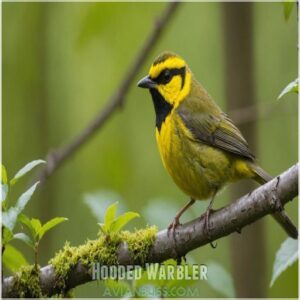
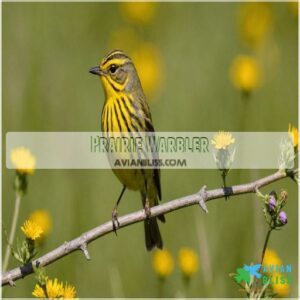
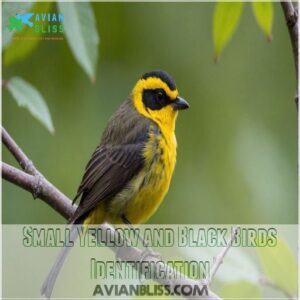
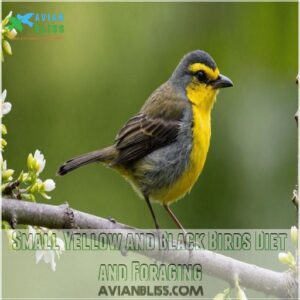
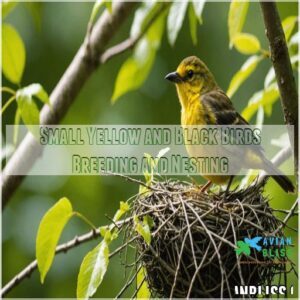


0 Comments